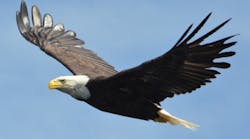Let’s Minimize Wind Energy Bird Kill
The organization I represent, the American Bird Conservancy (ABC), supports renewable energy development to address anthropogenic climate change, but has serious concerns about widespread bird mortalities caused by wind turbines, including impacts to protected species, such as whooping cranes and eagles, and smaller migratory birds. Indeed, wind energy cannot call itself “green” if it is killing hundreds of thousands of birds annually, including threatened, endangered and other protected species. Regardless of the slaughter, the wind industry has only paid lip service to bird protection laws, including the Endangered Species Act, Migratory Bird Treaty Act and the Bald and Golden Eagle Protection Act, and the federal government has been letting them get away with it. The response of the American Wind Energy Association (AWEA) has been to downplay these losses or to simply pass them off as minimal. Some environmental groups, hell bent to move us toward a sustainable future, have also ignored the collateral damage, while giving the wind industry a pass to kill protected species without criticism.
However, our mad rush toward renewable energy is looking more and more irresponsible. A recent study published in the Wildlife Society Bulletin estimated that 573,000 birds were being killed annually at 2012 build-out levels. The toll on bats was even greater, estimated at some 888,000 per year. Another recent study published in Biological Conservation estimates that the number of bird deaths due to wind power could reach 1.4 million per year by 2030. The notorious Altamont site in California—one of our nation’s worst-sited wind facilities-- has been estimated to have killed 2,000 or more Golden Eagles since it was commissioned in 1981.
Today’s turbines have the same basic structural design as they did thirty years ago – except that newer ones are taller and have longer blades. The increasing width of the blades, which can move at more than 100 miles per hour, raises the probability of striking flocks of birds migrating through the area or raptors such as eagles hunting for small animals living around the tower bases. But increasing tower height is even more ominous. A disturbing finding of one of the recent peer-reviewed studies was that bird collision mortality increased significantly with increasing hub height. However, we know that turbine height has increased by 50% in the past 10 years.
There is hope for the future. In December 2011, ABC petitioned the Department of the Interior to develop mandatory, science-based, effective permitting regulations that will safeguard wildlife and reward responsible wind energy development. Now a coalition of more than 60 groups has called for mandatory standards and adoption of Bird Smart © principles in the siting and operation of wind energy installations.
Because of increasing public scrutiny, laws are starting to be enforced. In November of last year the Department of Justice prosecuted Duke Energy in connection with the deaths of 14 Golden Eagles and 149 other protected birds at the company’s Top of the World and Campbell Hill wind facilities outside Casper, Wyoming. The settlement amounted to $1 million in fines and mitigation actions. This is the first prosecution of a wind company in connection with the deaths of protected birds. At least seven other cases are currently under adjudication.
However, ex post-facto legal action is not enough; the wind and electric utility industries need improved standards for minimizing bird (and bat) fatalities. In response, ABC has developed a set of Bird Smart © wind energy principles emphasizing careful pre-construction risk assessment leading to appropriate siting, post-construction monitoring, operational mitigation to minimize bird fatalities, and compensation, to redress any unavoidable mortality and habitat loss that may occur. When it comes to wind energy, the best mitigation is appropriate siting. Migratory bottlenecks, wetlands, raptor concentrations and key nesting areas should be avoided altogether. ABC has developed a wind map that shows critical bird migratory routes and breeding habitats that are inappropriate for wind energy development, and is hoping that both the industry and state and federal regulators begin using it as a tool. A national programmatic Environmental Impact Statement (EIS) for wind development would also be useful to define where wind energy should and should not be developed. Risks of wind power also extend to the transmission lines. Thus, ABC encourages management practices to avoid and minimize harm to birds, such as burying transmission lines in high risk areas and adhering to Avian Power Line Interaction Committee standards for above-ground lines.
Wind energy is marginally economical as it is, and these guidelines admittedly add additional construction, maintenance and monitoring costs. However, our nation’s native birds (and bats), whether on public or private land, are not owned by the for-profit wind industry. They are owned by the American people and held in trust for current and future generations. Ignoring the increasing bird (and bat) kill could eventually lead to an environmental and public relations crisis that might stall even the most sensible use of wind power in the U.S.



